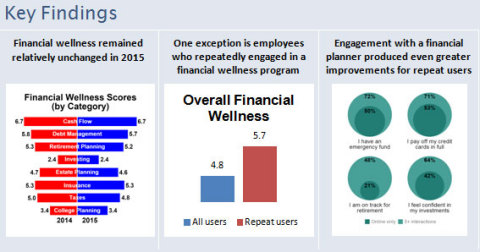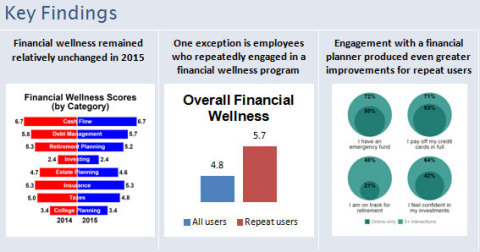EL SEGUNDO, Calif.--(BUSINESS WIRE)--In a year marked by increased market volatility and slow economic growth, it’s not a surprise that overall financial wellness levels remained virtually unchanged. Employees appear stuck, hitting a brick wall with debt, lack of emergency funds and inadequate retirement savings. However, the latest study from Financial Finesse shows that the way forward to improved employee financial wellness – and to narrow the financial Gender Gap – could be human-to-human coaching, with technology playing a supporting role.
The Year in Review: 2015, an analysis of employee financial trends based on anonymous data collected by workplace financial wellness firm Financial Finesse, describes a year where most employees have been treading water in terms of their financial wellness. Overall financial wellness levels were unchanged at 4.8 out of 10 vs. 4.7 in 2014.
The study shows that while technology was helpful in increasing employee awareness of their financial vulnerabilities, online interactions alone did not improve employee financial wellness. By contrast, employees who had five interactions including conversations on the phone or in person with a CERTIFIED FINANCIAL PLANNER™ professional showed substantial progress. Those repeat interactions with a financial coach appear to help an employee get “unstuck,” and advance in key areas. For these regular participants:
- 80% have a handle on cash flow, compared to 66% of online-only users
- 72% have an emergency fund, compared to 50% of online-only users
- 98% contribute to their retirement plan, compared to 89% of online-only users
- 48% are on track for retirement, compared to 21% of online-only users
- 64% are confident in their investment strategy, compared to 42% of online-only users
“Many employees are challenged in overcoming significant obstacles like debt and managing competing financial priorities,” said Financial Finesse founder and CEO Liz Davidson. “They make progress up to a certain point, but it’s the interaction with the financial coach that opens up possibilities and solutions and allows the employee to get `unstuck.' Technology can’t listen empathetically, brainstorm together, motivate, offer options for dealing with their specific worries and hold people accountable over time.”
Davidson noted that 71% of employees that repeatedly used their financial wellness programs were women, and this has likely contributed to narrowing the Gender Gap. A look at 31 key financial wellness questions revealed the overall Gender Gap in Financial Wellness declined from seven percentage points in 2014 to five percentage points in 2015. The Gender Gap continues to be the largest in areas of investing and money management, and smallest in areas of protecting the family, such as insurance and estate planning.
For those employees who haven’t shown much momentum, 2015 data illuminate many reasons overall employee financial wellness is neither advancing nor declining. “American employees continue to have troubling financial vulnerabilities,” explained Greg Ward, CFP®, Director of the Financial Finesse Think Tank. “Eighty-five percent of employees who completed a financial wellness assessment reported at least some level of financial stress. Concerns about debt and retirement are high. In fact, many employees first interact with workplace financial wellness programs in hopes of getting a handle on their debt.”
Ward suggested employers who offer financial wellness programs consider tailoring communications to address these vulnerabilities in particular:
- 58% may not be saving enough for retirement, with only 16% of Millennials on track to achieve their retirement goals.
- 51% don’t have an emergency fund. While this declines with age, a worrisome 25% of employees 65 and older still don’t have an emergency fund.
- 34% may be living beyond their means. For employees with family incomes of $100,000 or lower, less than half pay off their credit cards every month.
- 33% may have serious debt problems. Debt may be hurting African American and Latino employees the most, with 75% of African American and 66% of Latino employees saying getting out of debt is a top concern.
- Concern over market volatility is high. Many employees grew nervous about their retirement plan savings and turned to their financial wellness program for guidance on how to handle these market fluctuations.
Davidson said overall, companies providing financial wellness programs continue to see a reduction in the percentage of employees who reported having taken a retirement plan loan or hardship withdrawal, coming in at 23% in 2015, down from 30% in 2013. As more employers adopt robust financial wellness programs, she expects these improvements to continue.
About Financial Finesse
Financial Finesse provides unbiased financial guidance and education to employees through their employers, delivered as comprehensive financial wellness programs. Its education is proven to move the needle in employees’ financial security and provides a clear return on investment for their employers in productivity, absenteeism, health care costs and more. All programs are customized and holistic, delivered by CERTIFIED FINANCIAL PLANNER™ professionals who do not sell any financial products or manage assets. Its multi-channel education approach offers a variety of channels such as live workshops, webinars, one-on-one financial counseling sessions and a financial helpline—reaching over 2.4 million employees at over 600 companies. http://financialfinesse.com/




